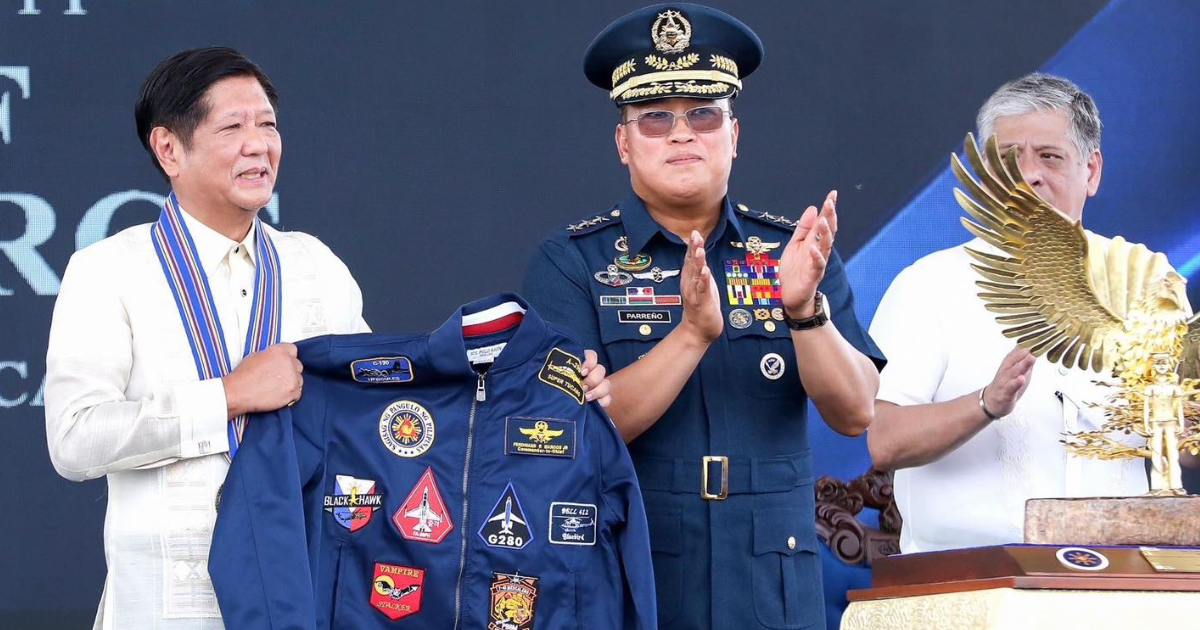Marcos vows to upgrade air force bases and equipment to defend Philippine skies
President Ferdinand Marcos at the Philippine Air Force’s 77th founding anniversary. Photo from the Presidential Communications Office.
By Manuel Mogato | Date 07-03-2024
MANILA — President Ferdinand Marcos has vowed to upgrade the military’s air bases and flying assets to protect and defend the country’s skies, pouring resources to modernize the air force.
Speaking at the 77th anniversary of the Philippine Air Force in Pampanga, Marcos promised “stern support” to the military’s capability upgrade. (Also read: Military modernization: a pipe dream)
“We have acquired additional aircraft, as well as advanced radar systems, which have transformed our operational readiness and enhanced our operational reach,” Marcos, the Armed Forces of the Philippines (AFP) commander-in-chief, said in a speech.
“These assets contribute to an agile Air Force—capable of protecting our nation, our people, and our resources and dedicated to ensuring that we are ready to face challenges with advanced precision, speed, and force.”
The president said his administration has consistently tried to acquire additional air assets, enhance cyber warfare communication systems, and pursue base development programs.
Marcos has approved a 1.3 trillion peso military modernization program to acquire vessels, aircraft, drones, helicopters, air defense radars, armored vehicles, and missile systems. (Also read: How to become a ‘Middle Power’ state)
The Air Force has embarked on an ambitious plan to cover the Philippines Air Defense Identification Zone (PADIZ) by 2028.
The plan includes acquiring trainer jets, four squadrons of multi-role fighters, ground support combat aircraft, attack and utility helicopters, armed drones, air defense radars, and surface-to-air missiles.
The defense department has signed a deal with an American company to deliver three C-130J and another deal with a Japanese company to install three-dimensional radars.
Israel has supplied ground-to-air missile systems to protect radar sites and other critical facilities.
The United States has promised more than $250 million to upgrade nine EDCA locations, mostly air bases across the country.
It has done $25 million in improvements in Basa Air Base in Pampanga, extending and asphalting the runway. The US also built hangars and warehouses for logistics.
It has also built fuel storage in an airbase in Cebu and a munition depot in Palawan.
For next year, the military has lined up 14 projects to develop the Lal-lo air base in Cagayan and the naval and airbase in Sta. Ana town in Cagayan and Balabac in Palawan.
Additional radar sites would be put up on the eastern seaboard, including the activation of a wartime air base in Guiuan, Eastern Samar.
Marcos also promised to take care of the Air Force’s health, housing, education, and economic assistance.
“As your Commander-in-Chief, I assure you of this Administration’s support in prioritizing your welfare, ensuring that you are well attended to in terms of overall health and wellness so you may perform your duties effectively and safely,” Marcos said.
Marcos said the government has also supported the Air Force’s initiatives to increase maritime domain awareness within the Philippine Air Force Defense Identification Zone by taking part in drills with allies and partners.
“We have also heightened our international defense and security engagements by sustaining our talks with our foreign military counterparts and participating in multiple bilateral and multilateral military exercises,” he said.
The Air Force has held two Cope Thunder exercises with the United States, a Marine Aviation exercise, and Balikatan this year.
With Australia, it would send a delegation to the annual Pitch Black drills. There were also drills with the Japanese and the South Koreans.
Marcos also praised the air force support to the Army’s internal security operations, conducting airstrikes, rapidly deploying and inserting combat troops, delivering logistics, and evacuating wounded soldiers.
“We have likewise supported internal security operations, which have resulted in the surrender and neutralization of over two hundred and fifty members of local insurgency groups,” he added.
The president also thanked the Air Force for helping in humanitarian missions and disaster relief operations.
He said the significant steps taken by the government to boost PAF capability are a testament to the government’s resolve to contribute to global peace and security.(Also read: Transparency and accountability in modernizing the military)

